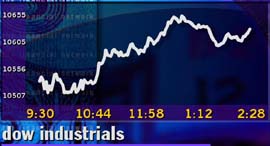|
Jobs decline, wages rise
|
 |
October 8, 1999: 3:42 p.m. ET
September data show 8,000 jobs lost; wage gain the biggest in 16 years
By Staff Writer M. Corey Goldman
|
NEW YORK (CNNfn) - U.S. job growth stalled in September while wages posted their biggest jump in 16 years, giving Wall Street a mixed picture of the pace of the economy and what it means for Federal Reserve interest rate policy.
Some 8,000 jobs were lost from the economy in September, the Labor Department reported Friday, well below the 218,000-job gain analysts had anticipated. Hourly wages jumped 7 cents to $13.37, topping the 4-cent gain forecast by analysts and the biggest monthly rise since September 1983.
The jobless rate remained steady at 4.2 percent, a 29-year low.
The report gave mixed signals to financial markets on how strong the U.S. economy is and whether slowing job creation or rising wage pressure is the economic order of the day.
"Weak employment growth but higher hourly earnings point Greenspan and the Fed in two different directions," said Bill Cheney, chief economist at John Hancock Securities in Boston. "Either the economy is slowing down and the Fed needs to sit tight, or inflation is starting to take off and another tap on the brakes may be necessary."
The Floyd factor
Stocks opted to listen to the better part of the report, with the Dow Jones Industrial Average climbing more than 100 points by mid-afternoon. Bonds took the more cautious road, slipping a moderate 7/32 to yield 6.19 percent, up slightly from Thursday.
At the same time, the effects of Hurricane Floyd on the numbers prompted some analysts and investors to ignore the report altogether and await future, more telling indicators.
"The September employment figures could be interpreted as signaling a slowdown in the economy with a pickup in wage growth, but don't count on it," said Mike Englund, a markets analyst with Standard & Poor's MMS in San Francisco. "The impact of hurricane Floyd might well have been larger than indicated."
Some 56,000 jobs were lost from the effects of Hurricane Floyd, according to a separate tally conducted by the Bureau of Labor Statistics. Had Floyd not disrupted businesses during its reign of destruction last month the economy would have generated 50,000 new jobs, the Labor Department said.
A confusing report
"It's a very confused report (and) the message is still ambiguous," said Charles Lieberman, an economist at First Institutional Securities. "This could be the beginning of something substantial, but it's hard to accept a number like that at face value. We'll need more numbers to digest."
After two quarter-point rate increases, in June and August, Fed policy makers opted to leave rates unchanged Tuesday, but signaled to financial markets that they're leaning toward raising rates in the future if they spot any sign of faster inflation. The Fed left the federal funds rate - the target rate it sets for banks to lend money to each other overnight -- at 5.25 percent.
Some analysts and investors had anticipated that Friday's report would provide a clearer sign of whether that next Fed move would come in November, December, the new year or not all.
Fed officials next meet Nov. 16 to discuss the economy and monetary policy.

The Dow wasn't sure how to take Friday's numbers, and then decided it liked them
Financial markets have had lots of numbers to digest, most of which point to strong growth yet surprisingly little inflation. Robust manufacturing output, strong consumer spending and a surging housing market, among other things, all have pointed to stronger-than-expected growth.
Separately, the Commerce Department reported Friday that August wholesale inventories jumped 0.3 percent, slightly below economists' expectations of a 0.4 percent gain though still suggesting products are flying off warehouse shelves. Wholesale sales rose 1.1 percent.
What's been the missing ingredient in the U.S. economic picture for months has been evidence of accelerating inflation -- the nemesis of stock and bond markets. Higher rates tend to slow the economy and dampen inflation, but they can also dent corporate profits, thus hurting stock prices.
Clearly disturbing
Some market-watchers saw that inflation in today's hourly wage gains.
"This is clearly a number on wage inflation that the market did not want to see," said Barry Hyman, a senior equity analyst with Ehrenkantz King Nussbaum in New York. "It's clearly disturbing to see wages at this level and I think it's going to weigh on the market for some time."
Fed officials have warned for some time about rising wage and benefit costs, since businesses' labor costs account for two thirds of consumer prices. In minutes of the Aug. 24 policy meeting released Wednesday, Fed policy makers expressed concern about rising wages and the effect that might have on consumer prices.

Employers want them, but there haven't been enough workers to go around
Other Fed officials, too -- particularly Chairman Alan Greenspan -- have voiced their concerns about the tight labor market and the lack of available workers required for a growing number of positions. The more employers need workers, the higher the wages they have to pay them, which can lead to inflation, according to the theory.
"On the surface, September's jobs report counters that view, but the key question remains: Why?" said Ian Shepherdson, chief U.S. economist with High Frequency Economics. "Weaker demand or lack of labor supply?"
Manufacturing, retail slows
Much of September's employment decline stemmed from the manufacturing and retail industries, the report said.
Services-related employment fell 9,000 in September, reflecting losses in retail and government jobs, while manufacturing employment declined 21,000, the report said. Construction employment rose by 21,000.
Average weekly earnings, meantime, rose to $459.93 in September from $458.85 in August; the percentage of unemployed workers who voluntarily left their jobs fell to 12.7 percent from 13.6 percent.
The total percentage of the U.S. population holding jobs was unchanged in September at 64.1 percent. 
|
|
|
|
|
|
Labor Department
|
Note: Pages will open in a new browser window
External sites are not endorsed by CNNmoney
|
|
|
|
 |

|

